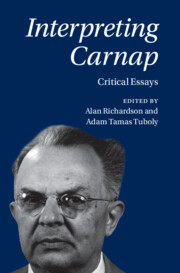Book contents
- Interpreting Carnap
- Interpreting Carnap
- Copyright page
- Contents
- Contributors
- Acknowledgments
- Abbreviations
- Introduction
- Part I Philosophy in New Dress
- Chapter 1 Carnap’s Noncognitivism
- Chapter 2 Carnap Is Not against Metaphysics
- Chapter 3 Interpreting Carnap’s Construction of the World
- Chapter 4 Philosophy in a Collective Spirit as “Politics in Its Broadest Sense”
- Part II Naturalism and Method
- Part III The Logical and the Linguistic
- Part IV Science and Theories
- Bibliography
- Index
Chapter 1 - Carnap’s Noncognitivism
Paths and Influences
from Part I - Philosophy in New Dress
Published online by Cambridge University Press: 01 February 2024
- Interpreting Carnap
- Interpreting Carnap
- Copyright page
- Contents
- Contributors
- Acknowledgments
- Abbreviations
- Introduction
- Part I Philosophy in New Dress
- Chapter 1 Carnap’s Noncognitivism
- Chapter 2 Carnap Is Not against Metaphysics
- Chapter 3 Interpreting Carnap’s Construction of the World
- Chapter 4 Philosophy in a Collective Spirit as “Politics in Its Broadest Sense”
- Part II Naturalism and Method
- Part III The Logical and the Linguistic
- Part IV Science and Theories
- Bibliography
- Index
Summary
With a view to highlighting the importance of archival and less well-known primary sources for our understanding of Rudolf Carnap’s philosophy, this chapter investigates several examples of concrete influences on his thinking, from nineteenth-century Herbartianism and empiriocriticism, the German Youth Movement, Bauhaus modernism and the revolution from the right, toward the Vienna Circle and post-WWII analytic philosophy. These examples demonstrate that Carnap’s philosophy had always been shaped by practical motives; he developed a philosophical stance that is directed at the reality of life and integrates cognitive as well as non-cognitive elements. This meta-philosophical view that carefully investigates the borders between the scientifically comprehensible (viz., the cognitive) and those aspects of reasoning that merely comprise personal attitudes (viz. the noncognitive) developed through various stages, from the "scientific world-conception" and antimetaphysics of the Vienna Circle toward Carnap’s mature views on inductive logic and human decision-making. The upshot is that noncognitivism as being understood by Carnap and his philosophical allies rather than denouncing value statements as arbitrary and irrational embeds them into a rational scientific discourse, to maximize rationality in connection with moral and political decision making.
Keywords
- Type
- Chapter
- Information
- Interpreting CarnapCritical Essays, pp. 13 - 31Publisher: Cambridge University PressPrint publication year: 2024



